
Chrysocolla cutting techniques in gemstone processing.
Inspecting the rough chrysocolla is the first step in determining the best approach for cutting. It is important to carefully examine the stone for any cracks, inclusions, or weak spots that could impact the final product. Once the stone has been assessed, marking it with a marker helps in planning the shape and minimizing waste. Cutting the stone involves using a trim saw with a diamond blade. This tool allows the rough chrysocolla to be cut into slabs or smaller pieces. It is crucial to maintain a constant flow of water to cool the blade and reduce dust. Safety goggles and gloves should always be worn to protect against flying debris and sharp edges.
Shaping the chrysocolla comes next, and a lapidary grinder is used for this purpose. Starting with a coarse grit wheel, the stone is roughly shaped. Gentle pressure is applied to prevent any cracking or breaking. Once the desired shape is achieved, the stone is further smoothed and refined using finer grits of sandpaper or diamond pads. Throughout this process, water is used to cool the stone and minimize dust. Finally, polishing the chrysocolla brings out its luster and vibrant colors. A polishing wheel, along with appropriate polishing compounds such as cerium oxide or tin oxide, is utilized for this step. The stone is polished until the surface is smooth and shiny, revealing the beauty of the chrysocolla.
Chrysocolla druzy can also be cut into cabochons and used in jewelry. Stones that are cut and polished from chrysocolla are best used in pendants and earrings, which are less likely to knock against something and break. Another important thing to keep in mind about chrysocolla, is that it’s a soft mineral and therefore very sensitive to water. When working with it, do not leave it sitting in water for long periods of time. Chrysocolla cuts well using both standard diamond wheels as well as cerium oxide belts. Polishing with diamond and green rouge (zam) will work wonders when polishing softer copper minerals, like chrysocolla.
Chrysocolla is an incredibly beautiful and vibrant copper silicate mineral. It has been used in sculpture and jewelry throughout history. This ancient stone has always been highly valued and continues to be well loved and known for its vivid color, unique properties, and versatility. Chrysocolla usually does not heal. However, in some cases it may be coated with a colorless resin. Care and maintenance of jewelry with chrysocolla stones. Chrysocolla is a relatively soft gemstone, so you should always take care of it to maintain its attractiveness. This stone can be easily scratched with precious stones and other jewelry, so you should wear it separately and clean it. When cleaning Chrysocolla gemstones, use a soft cloth or brush and plain soap and water.
Do not use ultrasonic cleaners or steam cleaners and strong household chemicals such as bleach or sulfuric acid. To prevent discoloration of the stone, avoid prolonged exposure to direct sunlight and excessive heat. Chrysocolla gemstones should always be kept separate from other gemstones and jewels. When storing chrysocolla, it is best to place it separately in a cloth or in a cloth box. Take off your jewelry before exercising or doing hard household chores.
When working with chrysocolla, it is important to consider a few tips. Avoid exposing the stone to heat, as it can cause cracking. Always use water to keep the stone cool during cutting and grinding. Additionally, handle the stone with care due to its softness on the Mohs scale. To enhance durability and appearance, some artisans apply a protective coating or resin to chrysocolla. Chrysocolla is usually cut into domes and dice. Some items may be cut into polygons (angular or icy), but this is not very common. It is usually done only for collectors, not for use in jewelry. Most chrysoculas are oval and free-cut, but fancy shapes are also very common. More popular shapes include circles, tears, trillions, baguettes and water drops. Calibrated sizes have a greater right to action.
-
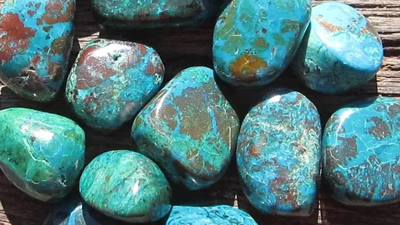
Chrysocolla is a captivating gemstone known for its vibrant blue and green hues, classified as a hydrated copper phyllosilicate mineral. It typically forms in the oxidation zones of copper deposits, with notable sources including Arizona, New Mexico, Chile, Peru, and Israel. The gemstone exhibits a hardness of 2. 5 to 3. 5 on the Mohs scale, making it relatively soft and requiring careful handling. Its luster ranges from vitreous to dull, and it can be opaque to translucent. Chrysocolla is often used in jewelry as cabochons or beads due to its attractive colors and is also valued for its metaphysical properties, believed to enhance communication and self-expression. Additionally, it has applications in decorative objects and carvings.
Despite being lesser-known, Chrysocolla"s unique characteristics make it sought after by gem enthusiasts. The name derives from Greek words meaning "gold" and "glue
-
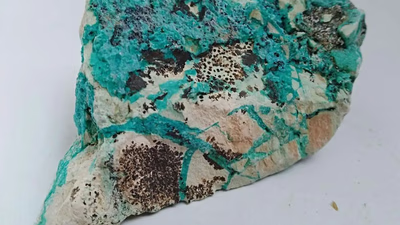
Inspecting rough chrysocolla is essential for determining cutting methods. The stone should be examined for cracks and weak spots before marking it for cutting. A trim saw with a diamond blade is used to cut the stone into slabs, ensuring a constant water flow to cool the blade and minimize dust. Safety precautions, including goggles and gloves, are necessary during this process. Shaping involves using a lapidary grinder with coarse grit wheels, followed by finer grits for smoothing. Polishing enhances the stone"s luster using a polishing wheel and compounds like cerium oxide. Chrysocolla can be fashioned into cabochons for jewelry, particularly pendants and earrings, due to its softness and sensitivity to water. Careful maintenance is crucial; avoid prolonged exposure to water, direct sunlight, and harsh chemicals.
When cleaning, use a soft cloth with mild soap. Store chrysocolla separately from other gemstones to prevent scratches. Artisans may apply protective coatings to enhance durability. Common shapes include ovals and free-cuts, while calibrated sizes are preferred for specific applications. "
-
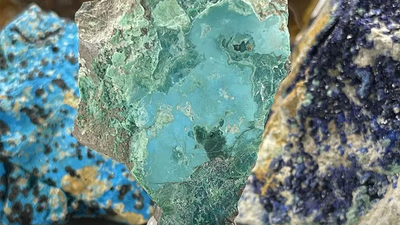
Chrysocolla is identified through visual inspection and physical property testing. Its color ranges from blue to green, often displaying mottled patterns. The hardness of chrysocolla is between 2. 5 and 3. 5 on the Mohs scale, making it softer than turquoise. Specific gravity tests reveal values between 2. 0 and 2. 4, while the streak test shows a white to light blue-green powder.
Due to its variable chemical composition, chrysocolla can be confused with similar minerals like turquoise and azurite. Notable sources include Arizona, Israel, and the Democratic Republic of Congo, with advanced techniques like spectroscopic analysis and X-ray diffraction aiding in identification. For accurate results, consulting a professional gemologist is recommended, especially when purchasing valuable pieces. Buyers should seek certification from reputable laboratories and buy from trusted dealers to ensure authenticity.
-
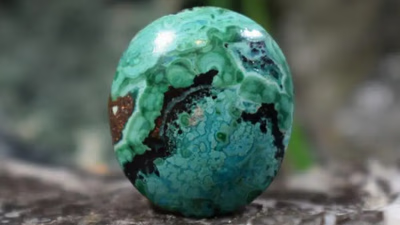
Chrysocolla and turquoise, while both featuring vibrant blue to green hues, are distinct minerals with unique properties. Chrysocolla is a hydrated copper phyllosilicate, softer than turquoise, which is a hydrated phosphate of copper and aluminum. The hardness of chrysocolla ranges from 2. 5 to 3. 5 on the Mohs scale, whereas turquoise measures between 5 and 6. Their luster also varies; chrysocolla typically has a vitreous to dull finish, while turquoise displays a waxy to subvitreous sheen. Geologically, both stones are associated with copper deposits but differ in structure: chrysocolla often appears botryoidal or massive, while turquoise is found in nodules or veins within host rock. Specific gravity further distinguishes them—chrysocolla"s ranges from 2.
0 to 2. 4 compared to turquoise"s 2. 6 to 2. 9. Chrysocolla"s attractive light blue and turquoise green colors stem from copper impurities, making it sought after by gem enthusiasts despite being lesser-known than turquoise. The name "chrysocolla" derives from Greek words meaning "gold" and "glue
-
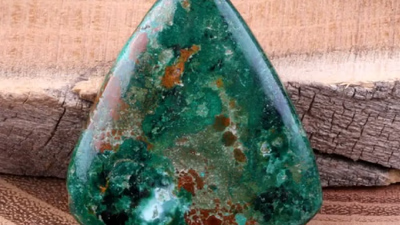
Chrysocolla is a unique gemstone characterized by its vibrant blue to green hues, often found in massive or botryoidal forms. Its appearance can vary significantly based on its mineral associations, such as when combined with quartz, resulting in varieties like Chrysocolla Chalcedony. Other notable combinations include Eilat Stone and Sonora Sunrise, which showcase striking color patterns. Identifying chrysocolla involves examining its color distribution, hardness (2. 5-3. 5 on the Mohs scale), specific gravity (2. 0-2. 4), and luster.
While pure chrysocolla is rare, it is often sold mixed with other minerals under the same name. Similar gemstones include turquoise, malachite, azurite, and variscite, each differing in hardness and appearance. Pricing for chrysocolla jewelry depends on factors such as weight, color purity, cutting quality, and transparency levels ranging from D (clearest) to M (most opaque). Understanding these characteristics is essential for both buyers and sellers in the gemstone market.





